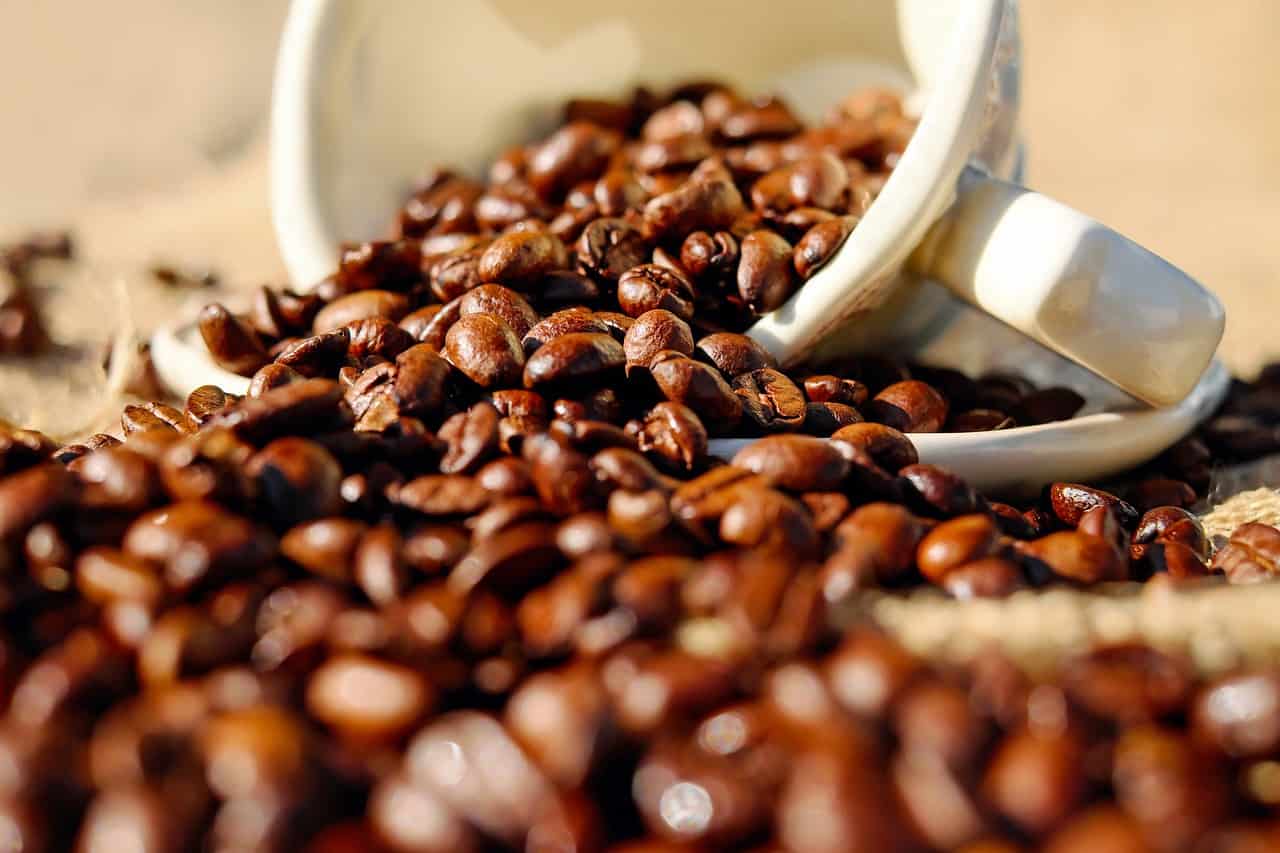Latte, a hot, delicious coffee made by mixing espresso and steamed milk, has become one of the most common coffee orders in coffee shops and cafés around the world. A latte is an ideal choice for those who can’t tolerate the bitterness of black coffee or those who enjoy taking their time to sip their cherished cup.
The sweet, milky coffee can accompany you in the morning, afternoon, and even the evening, with restaurants reporting a rising trend in people ordering a latte to finish off their evening meal.
If you are also one of these people, you may have noticed having trouble sleeping that night. Wonder why?
A latte can contain a surprisingly high amount of caffeine, making it harder for you to rest and eventually fall asleep. Let’s help you determine how much caffeine is safe to consume after your dinner and how a latte compares to other caffeinated drinks available to you.
How Much Caffeine is in a Latte?

Even though lattes originate from Italy, their version is completely different from what we consume under the name of “latte.” Here, if you order a latte, you can expect a coffee drink served in either a tall glass or a mug, with one or a double shot of Espresso (one or two ounces, 30-60 ml), filled up almost to the rim of the cup with steamed milk, finished off with a layer of milk foam on top. In Italy, you would get a version with heated milk instead of a steamed one, with no foam or sweeteners added to it.
The espresso content in a latte is what determines the final amount of caffeine in a latte. You can expect your latte to have between 60-80 mg of caffeine and if you ordered a double shot, 120-160 mg of caffeine.
You can already see that caffeine-wise, this is no different from the normal coffee that you may brew at home. Taking this into account, you may want to modify your post-meal coffee order to something not quite as strong or request your latte to be made with decaf coffee.
Can You Make a Decaf Latte?
Purists would say no, but I strongly disagree with this opinion. You can definitely make and enjoy a latte that does not contain caffeine or only contains a minimal trace amount of it.
I’ve read blogs claiming that using decaffeinated coffee for your lattes defeats the purpose entirely, with some claiming the end result can’t even be called a latte!
Excuse me, what?
It’s an outrageous take and you don’t have to feel any shame asking for a latte decaf. Most places that offer decaffeinated coffee on their menu are always happy to accommodate. You are the customer after all.
Some servers even go that extra step, explaining before your order is confirmed how much caffeine there is in the latte and suggesting the decaf as an alternative.
Even better, you can just as easily make a decaf latte at home, substituting your usual coffee for a decaffeinated one. This way you can still enjoy the rich, milky latte even if it’s midnight and you want to sit and enjoy a nice coffee whilst finishing your favorite film!
Alternatives to Latte for Caffeine Boost
If a latte isn’t your thing or you’ve already had one today, it’s good to know you have alternatives for getting that sweet caffeine boost your body so desperately craves. Ranging from coffee varieties to energy drinks, there’s something for everyone:
- Espresso – all the caffeine with none of the filler.
Average serving size: 1 oz / 30 ml – 60-80 mg of caffeine
- Black tea – a good coffee alternative, the English favorite.
Average serving size: 1 cup – 50 mg of caffeine
- Energy drinks – easy to pick up at the supermarket, with the downside of a high sugar content
Average serving size: 1 can – 90 mg of caffeine
- Soft drinks – Pepsi, Coca-Cola, Dr. Pepper, and other varieties can help you out in a pinch and are easily found in vending machines.
Average serving size: 1 can – 30 mg of caffeine
What Kind of Coffee is in a Latte?
Traditionally, a latte is made with espresso-type coffee. Espresso is a super-concentrated, low-volume, high-caffeine type of coffee brewed using a high-pressure method with a special Espresso maker. At home, you can use a capsule coffee maker programmed to Espresso mode or a commercial espresso machine for brewing your base coffee.
The first step to making a latte is brewing your espresso. You’ve probably noticed a huge espresso machine in every cafe or restaurant you frequent, and that’s the key to getting the perfect base for your latte. A machine coffee or a French press coffee would dilute the latte way too much, making espressos the exclusive choice of coffee for lattes and other coffee drinks.
The variety of coffee beans used for the espresso is the most important factor in determining how much caffeine ends up in a latte. Thanks to the bean’s chemical composition, a blend composed mostly of Robusta-variety produces a higher caffeine coffee than one mostly made using Arabica.
What’s the Difference between Cappuccino vs. Latte vs. Macchiato?
Most cafés and restaurants offer a wide variety of coffee drinks, like lattes, cappuccinos, and macchiatos. If you were to ask about each one of them, you’d probably get an answer that sounds like “Oh, it’s coffee with milk.”
Can’t argue with that.
However, these are all different drinks and you should know the key differences between them.
- A Latte has a high ratio of steamed milk to coffee, depending on the amount of coffee used but at least 2 to 1. The latte is made using espresso and steamed milk and comes with a thin layer of milk foam on top of the drink.
- A Cappuccino uses both steamed and foamed milk, usually in a ratio of ⅓ steamed milk, ⅓ foamed milk, and ⅓ espresso. A cappuccino also has a thick layer of milk foam.
- A Macchiato is made by adding a splash of milk to a shot of espresso. A Macchiato is way smaller than a latte or a cappuccino due to the low volume of milk used.
As you can see all of these coffee drinks are made using espresso and thus have a similar caffeine content – about 60-80 mg per shot of coffee. If you need to choose between these drinks, remember that there’s really no difference in how much caffeine there is in a latte, macchiato, or cappuccino.
Factors that Affect Caffeine Content of Latte
We have already learned that the caffeine amount is fully dependent on the coffee blend your coffee is brewed with.
If you are having a coffee outside in your garden and are curious to know about the estimated caffeine content, do not hesitate to ask the barista or server about it next time you visit your favorite café. If they can tell you what beans they use, you can do your own research online to find a mostly accurate estimate.
As a rule of thumb, Robusta blends have a higher caffeine content than Arabica ones, with a slightly different taste as well.. It can be hard to tell the difference when having sweet and milk-diluted coffee, but Robusta beans give the coffee a burnt and chocolatey flavor, while Arabica offers a much lighter flavor.
How to Order a Low-Caffeine Latte?
If you are planning to order a low-caf or no-caf latte, plan ahead accordingly.
First, see if the place offers decaffeinated coffee of any kind. If not, there is a high chance they won’t be able to make you a low-caf or no-caf coffee.
In that case, you might have to request your latte to be made with a half shot. It’s gonna get some possible weird looks but it could be your only option if you’re really craving a latte but can’t handle the caffeine.
If they do offer decaffeinated coffee, ask the barista to use decaf when making your latte. Sometimes, substitutions like this can cost extra. If you don’t want the unwelcome surprise of finding out your coffee is more expensive than expected, ask if it costs extra to sub regular espresso for a decaf one.
How to Customize Your Latte’s Caffeine Content?
If you are at home making your own latte, you can freely play around and experiment with the amount of coffee or milk you use to make your drink.
You can even come up with your own signature coffee blends if you’re feeling creative. Why not try mixing regular and decaf ground coffee to make a weaker espresso and decrease the caffeine content?
Of course, it’s not as easy when you’re out. Some coffee places display extra information about their coffee, like the type of beans they use for brewing or info on how much caffeine there is in their latte or other drinks.
Depending on the café, some are open to substituting your coffee for a decaffeinated one or even adding an extra shot of espresso if you’re looking for that caffeine boost.
Some may only offer substitutions for their regulars depending on the relationship built between a customer and barista, so always make sure to ask with a smile on your face. In short, when in doubt, check the menu to see what options are available to you.
FAQ‘s
Do Lattes Have More Caffeine Than Drip Coffee?
Lattes contain a smaller amount of caffeine compared to a drip coffee, thanks to using a small-sized espresso as the drink base. Espresso has a concentrated caffeine content of 60-80 mg per serving, and drip coffee can give you 80-120 mg of caffeine per cup. So as turns out, lattes have only half the caffeine of a cup of regular drip coffee.
How Much Caffeine is in 2 Shots of Latte?
A latte made with 2 shots of espresso will have 120-160 mg of caffeine, depending on the variety of coffee used by the maker. You can expect the double-shot to give you a double-strong, long-lasting boost of energy.
Does Latte Contain More Caffeine Than Cappuccino?
Latte and cappuccino are both made using a shot of espresso, so without any requested modifications, you would receive the same amount of 60-80 mg of caffeine from both. If you need a higher or lower caffeine content in your drink ask if accommodations can be made.
Final Words
Lattes are a perfect companion to you and that big slice of cake you can’t wait to order, offering a sweet, milky, and mild flavor you can find nowhere else in the coffee family.
Perfect for any season, whether it’s the increasingly popular iced lattes to keep you cool in the summer or a comforting warm cup to curl up with during the winter, the latte will always be the most tasty of companions.

